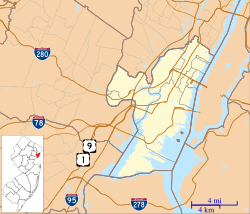The Beacon (Jersey City) facts for kids
|
Jersey City Medical Center
|
|
The Beacon in 2020
|
|
| Location | Roughly bounded by Montgomery Street, Cornelison Avenue, Dupont Street and Clifton Place, and Baldwin Avenue, Jersey City, New Jersey |
|---|---|
| NRHP reference No. | 85003057 |
Quick facts for kids Significant dates |
|
| Added to NRHP | November 27, 1985 |
The Beacon is a special place in Jersey City, New Jersey. It's a huge complex of buildings that used to be a hospital. Now, it has been changed into homes and shops. The Beacon sits on a hill called Bergen Hill. This spot is one of the highest points in Jersey City.
The Beacon is built inside the old Jersey City Medical Center. This large area covers about 14 acres (about 56,000 square meters). It includes around 1,200 fancy homes and many shops. The old hospital moved to this location in 1882. Over the years, more buildings were added. The project to turn the old hospital into The Beacon started in the early 2000s and was finished by April 2016.
This historic complex is so important that it is listed on both the national and New Jersey lists of historic places.
Contents
The Beacon: A Historic Transformation
From Hospital to Homes: A New Purpose
The Jersey City Medical Center was once a very important hospital. It was built up over many years. During the Great Depression, new buildings were added. This was part of a big project called the Works Progress Administration. Mayor Frank Hague helped make this happen.
The hospital was very grand inside. It had shiny marble walls and beautiful terrazzo floors. There was also etched glass, fancy decorations, and sparkling chandeliers. One of its most famous parts was the Margaret Hague Maternity Hospital. Many babies were born there. By the 1940s, it was the third-largest medical center in the world!
From 1956 to 1968, a medical school was located there. It was called the Seton Hall College of Medicine and Dentistry. Later, the hospital became a private, non-profit organization in 1988. In 1994, it became a special trauma center. This means it was set up to help people with very serious injuries.
Bringing Old Buildings Back to Life
A company called Metrovest Equities started changing the old hospital in 2003. They officially took over the property in 2005. The plan was to turn ten historic buildings into homes. These buildings have a special design style called Art Deco. This was the biggest project of its kind in New Jersey's history. It cost about $350 million to complete.
The buildings at The Beacon are very important. They are listed on the New Jersey Register of Historic Places and the National Register of Historic Places. This means they are protected because of their history and design.
The first buildings to be fixed up were called the Rialto and Capitol buildings. They are now homes and places for fun activities. Fixing these two buildings alone cost over $133 million. It took more than four years to finish. In 2009, the people who worked on restoring these buildings won a special award. It was for their excellent work in bringing these old buildings back to life.
See also


